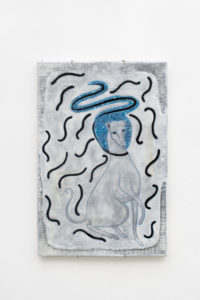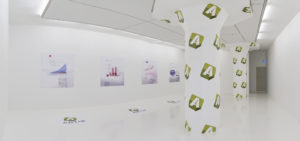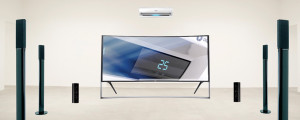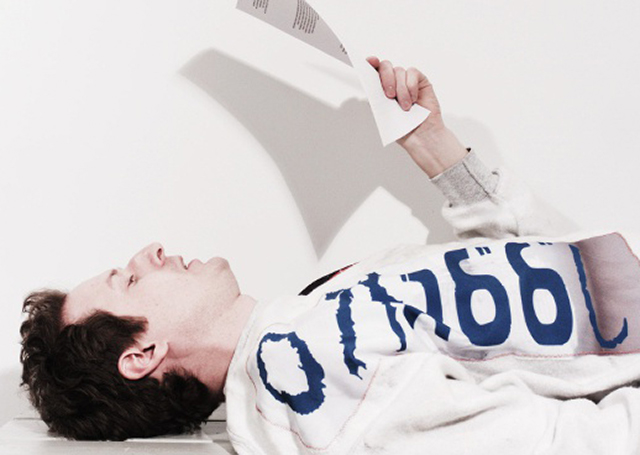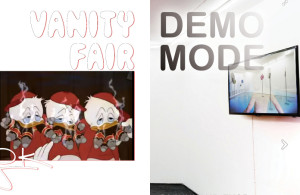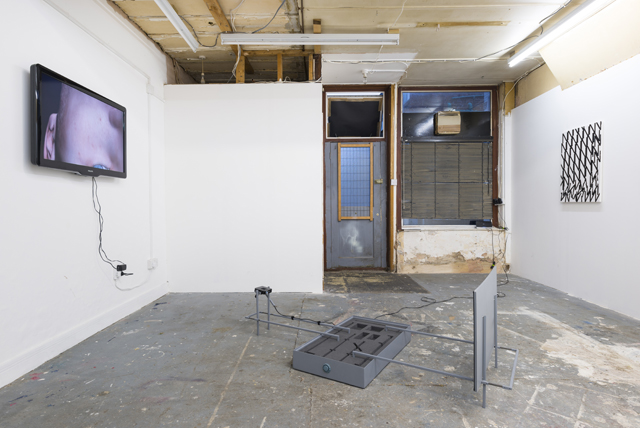Saemundur Thor Helgason is wearing Nike trainers and a collarless shirt I suspect might be from Cos when I meet him. He brings with him his laptop, a chunky thing with an alien’s head on the back of the screen. It is, he tells me, Alienware. A subsidiary of Dell, Alienware make laptops designed, according to their publicity, for “intense gaming.” His hair is smart, long on top and short on the sides. He is handsome, and his clothes are clean. I have come from work, I’m tired and my clothes are dirty and this makes me feel a little insecure, however he is also charming and understated and this puts me at ease.
The interview is conducted in two stages; the first in the back of Number 67, the café attached to the South London Gallery, the second over email. I ask him if he had a chance to look around the current exhibition, In-Between by Thomas Hirschhorn, and he says he popped his head in briefly. “It’s not my cup of tea.” It’s unsurprising that he’s not so into it. Aesthetically, Hirschhorn deals in a kind of self-conscious shabbiness, using cardboard and duct-tape to contrive an immersive reconstruction of an imagined ruin. His work is explicitly political; a banner at the back, evocative of protests and the Occupy movement, proclaims a statement by an influential Marxist thinker.
Helgason, by contrast, is a man of very clean lines. More, the political content of his work is murky, opaque; at one point he actively shuts down an (admittedly leading) question, “I don’t want to talk about right or left wing politics.”
We’re actually here to talk about his recent work, ‘Things to return to the store’ (2015), exhibited at the Goldsmiths MFA Degree Show, and comprehensively documented on his Youtube channel.
The work involves a variety of high-end consumer products; a TV (Samsung UE48JU6500 Curved 4K… etc.), sound system (Panasonic SC-BTT505…), and luxury fan (Dyson AM05 Hot & Cool™…). The two devices with media-playing facilities run playlists of promotional materials, sourced from Youtube. The materials themselves promote the other devices in the work, thereby facilitating an interplay between the commodities, and forcing a type of collaboration.
The work itself is a failure; the title testifies to this. Initially, Helgason had hoped that he might be given even more high-end devices, on loan, in a kind of sponsorship deal by the companies. Instead, rejection emails, distorted across a wonky digital landscape and watermarked with the letters F, A, I, L, U, R and E are vinyl-ed onto the windows. He was forced to spend £1,700 in John Lewis, and make sure that the packaging and products themselves were kept in pristine condition, so that he could take advantage of the department store/British Institution’s notoriously noble returns policy.
The fetishistic treatment of these consumer-totems is a little troubling, even if we take for granted the idea that a brand-oriented visual language is the most appropriate to, and formative in, our day-to-day experiences.
This is a work bathed in the cold, enticing and aspirational gloss of wanton consumerism – the soundtrack to the video-documentation (itself shot with all the elegance and soullessness of the films played on the devices within it) has been lifted from one of the promo-videos. It is anxiety-inducing in its simultaneous inhumanity and the culturally-conditioned yearning it invokes. And yet, within the recursive system Helgason has used the devices and promotional material to create, lies a kind of nuanced and apolitical subversiveness; these products are presented neither critically nor uncritically. Instead, an environment is created in which they can be viewed with something that most closely resembles objectivity.
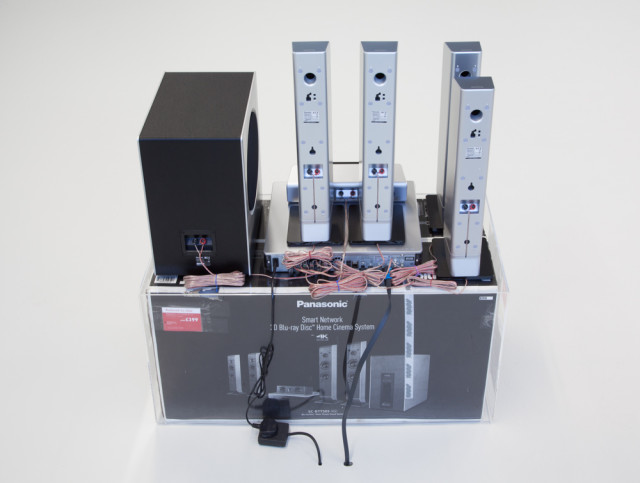
You refer to the process of approaching the companies almost as an experiment, in “producing art without spending any money”. Can you expand on the significance of money/not spending any? Why and how did this initially come up as a concern? Is it purely practical, or does it relate to a broader set of issues?
Saemundur Thor Helgason: By collaborating directly with the companies that manufacture the audio-visual equipment and air-conditioning units, I would be able to enter the market through its back door, bypassing the otherwise pre-imposed consumer relationship. The process of approaching the companies originates from a concern of getting by as an artist. It is practical but I guess it has its political implications.
What’s your position on the ethics of involving corporations and brands and their identities in a kind of, neutral or gallery context?
STH: ‘Neutral’. I mean, okay, so if I’m making videos for example, you have to include those brands, they are already there: if you use a screen, the screen has a logo. It’s manufactured somewhere, and it has its surplus image already, it’s identity as a device. And even if you don’t address it directly, it kind of hovers over the work. If you put a piece of tape over the brand, it doesn’t escape that fact that it’s already there.
I come from a more structuralist practice; doing something in the style of structuralist filmmaking. For example, recording the process of installing the equipment that shows the recording. Those kind of self-referential works.
I looked at them as kind of neutral, like there was no content, no message. But then actually I started looking closer at the equipment and the clothes that I was wearing – if it was a performance I’d have, like, Nike shoes. That already embodies meaning; the work kind of becomes contaminated by the marketed image of those devices.
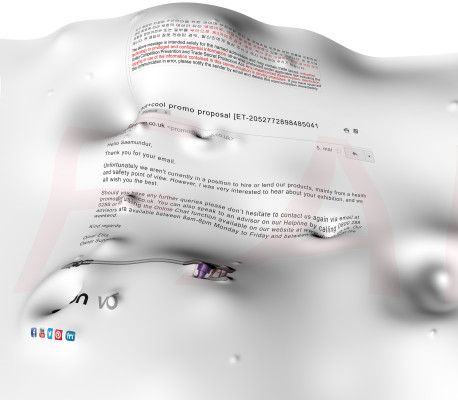
When you talk about “structuralist” filmmaking, to clarify, is this ‘structural film‘ as opposed to film that specifically relates to like, Adorno’s structuralism?
STH: Yes, structural- or material film from the 60s and 70s. Artists and filmmakers would have the apparatus for producing their films in the foreground and the depicted image secondary. Similarly, I have centered my work on the market conditions that constitute its production, although my interest has shifted toward the display itself and the way it is already charged with a marketed image before the device is purchased and additional material played on it.
You describe the commodities in your work and the gallery (like the Nike trainers you wear during a performance, the branded TV an art film plays from) as “contaminating” the self-referential works you’re interested in producing. Is this possible because the recursive, self-referencing loop of structural film is too closed, and therefore any contaminant that gets into the system is, in a way, amplified?
STH: Yes, totally. It is hard to produce a closed system. Even when you demarcate a small part of a larger system, it remains incomplete. There is always another element that it relies on. I think the very problem of self-reference is that the medium cannot depict itself, and relies on another medium. Implicit metadata – generally referred to as ‘noise’ or ‘artefacts’ – which wasn’t added intentionally as a way of documenting the information but comes as part of the side effect of the process by which information was captured. It comes probably closest to a ‘medium mediating itself’, but it relies on a file being created containing explicit information, e.g. a jpeg, pdf, mp3 etc. It does not ‘go meta’ in the sense of ‘jumping outside’, rather it’s an act of diving into the data by looking at its characteristics.
The commodities within the work open up- and in a way conflict with – the closeness of the loop, e.g. by their image circulating on the market. One could also see it the other way around, that additional content played on the audio-visual devices contaminates the purity of their marketed image.
In approaching the companies, did you tell them their devices would be playing their own promotional material, or that you would be showing other companies promotional material on their devices?
STH: I did tell them that it would form a collaboration between products. Some companies had problems with displaying their product next to another product, the competing company on the market.
After the companies rejected your approaches, how much did you spend on the devices?
STH: In total £1,700. The television was on sale, but it was this curved screen, 4K screen. It was important that it was 4K.
Why?
STH4K is twice the quality of HD, the highest picture quality the market has to offer at the moment. As the work consists of the newest audio-visual devices available on the market today, the work is in 4K.
Until December 2015 there is no media player available on the market that can play 4K-quality videos. So far the only way to play 4K quality video is through YouTube or Netflix, which influenced the choice of playing the existing promotional material (some of which is in 4K) directly from a YouTube playlist that I assembled.
I find the 4K landscape demo videos produced by the audio-visual manufacturers fascinating in the sense that they reduce a landscape to a backdrop for demonstrating the amount of pixels 4K has to offer. In this sense, the depicted landscape is there only to represent the pixel.
In an earlier conversation you spoke about creating a space in which the audience can “contemplate” the devices. This almost suggests that you consider there to be some kind of spirituality or otherness at work within the devices, which requires contemplation; do you think there’s something innately powerful in these commodities, besides their status as consumer goods?
STH: The marketed image is meant to operate on a subconscious level, entering the consumer almost unnoticed. I find it interesting to have their image in the foreground, looking at their identity, so to speak. In ‘Things to return to the store’ I thought of the devices as displaying themselves and demonstrating their qualities. They are ‘spiritual’ in the sense of their constructed image in relation to the devices themselves and how they interplay.
How did the companies’ rejection impact on your feelings about the exhibition? Were you in the end happy to readjust your ambitions for it, or was it a disappointment?
STH: No, I thought it was quite funny. In the end the surround sound system was displayed on one plinth, coming from one direction. I thought it was quite funny; it was a failure for the work. There was a watermark running through the whole print on the walls, which said ‘failure’. One letter on each window, too large to even notice it.
By grouping the surround-sound system together, you’re kind of satirizing it; there’s a kind of implicit criticism in not using it properly. Presumably had the work been successful the companies would have issued guidelines on how they wanted the objects used. Did their rejection make you more critical of them?
STH: Yeah, yeah. I got more critical towards them of course. Yeah. I’m writing about this at the moment for the dissertation. How to take a critical stance towards something that you are entangled completely in; where are you pointing in the end? It’s quite difficult, I guess, to claim to be against the idea of these kind of branded things being there. But I’m not necessarily for it either. It’s just like, neither, nor. But yeah, I guess that’s the tricky part, that’s also what people ask me all the time, like, what is my position. Who am I pointing at? It’s difficult. I mean, I want to point at myself. **
